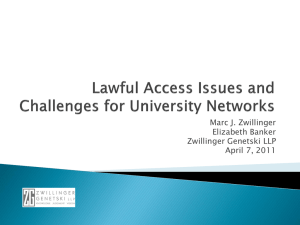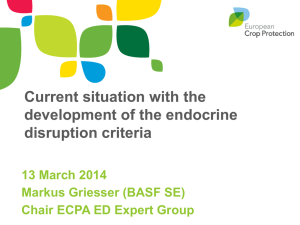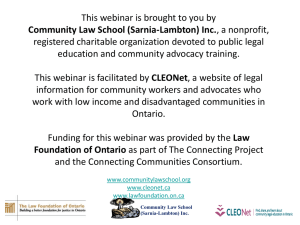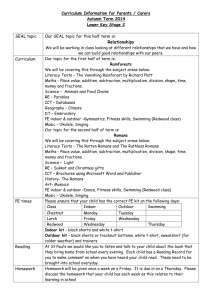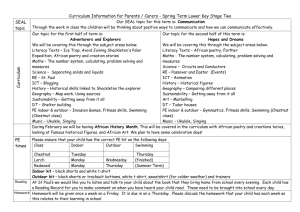ECPA SpERCs
advertisement
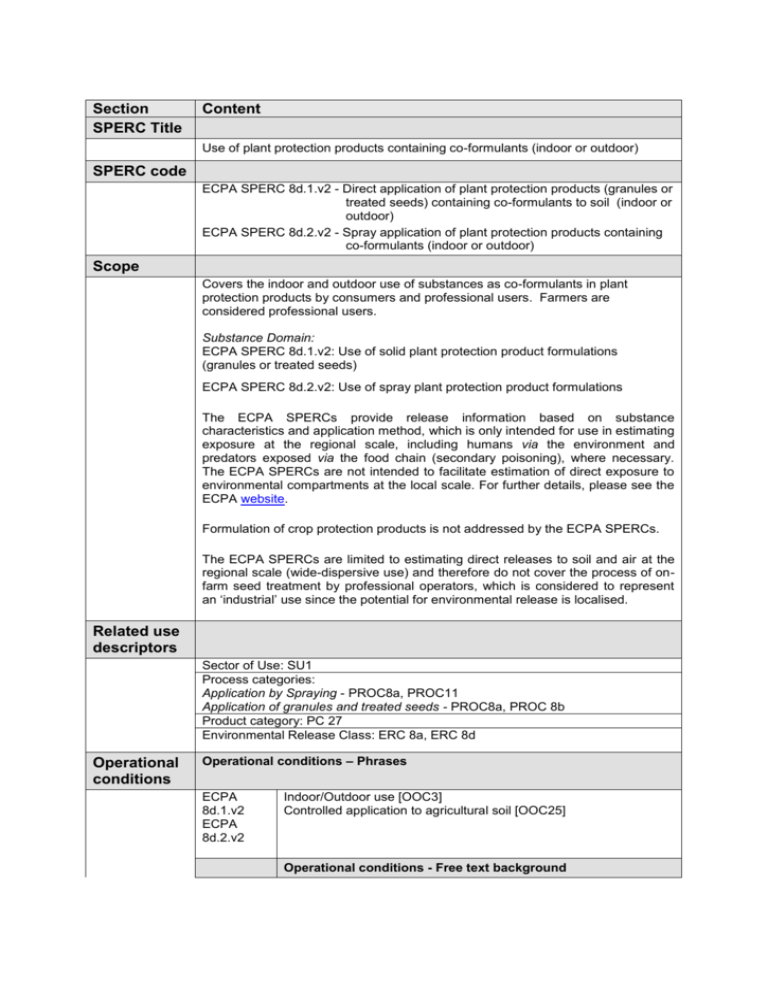
Section SPERC Title Content Use of plant protection products containing co-formulants (indoor or outdoor) SPERC code ECPA SPERC 8d.1.v2 - Direct application of plant protection products (granules or treated seeds) containing co-formulants to soil (indoor or outdoor) ECPA SPERC 8d.2.v2 - Spray application of plant protection products containing co-formulants (indoor or outdoor) Scope Covers the indoor and outdoor use of substances as co-formulants in plant protection products by consumers and professional users. Farmers are considered professional users. Substance Domain: ECPA SPERC 8d.1.v2: Use of solid plant protection product formulations (granules or treated seeds) ECPA SPERC 8d.2.v2: Use of spray plant protection product formulations The ECPA SPERCs provide release information based on substance characteristics and application method, which is only intended for use in estimating exposure at the regional scale, including humans via the environment and predators exposed via the food chain (secondary poisoning), where necessary. The ECPA SPERCs are not intended to facilitate estimation of direct exposure to environmental compartments at the local scale. For further details, please see the ECPA website. Formulation of crop protection products is not addressed by the ECPA SPERCs. The ECPA SPERCs are limited to estimating direct releases to soil and air at the regional scale (wide-dispersive use) and therefore do not cover the process of onfarm seed treatment by professional operators, which is considered to represent an ‘industrial’ use since the potential for environmental release is localised. Related use descriptors Sector of Use: SU1 Process categories: Application by Spraying - PROC8a, PROC11 Application of granules and treated seeds - PROC8a, PROC 8b Product category: PC 27 Environmental Release Class: ERC 8a, ERC 8d Operational conditions Operational conditions – Phrases ECPA 8d.1.v2 ECPA 8d.2.v2 Indoor/Outdoor use [OOC3] Controlled application to agricultural soil [OOC25] Operational conditions - Free text background ECPA 8d.1.v2 ECPA 8d.2.v2 Obligatory onsite RMMs ECPA 8d.1.v2 ECPA 8d.2.v2 Substance use rate ECPA 8d.1.v2 ECPA 8d.2.v2 Labeling required as part of plant protection product approval process under Directive 91/414/EEC (now Regulation (EC) 1107/2009) lays out specific operational conditions which must be followed in order to ensure environmental safety. Product labeling also provides guidance regarding appropriate disposal. It is normally recommended that plant protection product containers are triple or pressure rinsed or rinsed with a system that is an integral part of the sprayer. Washing water is normally added to the sprayer at time of filling and disposed of safely (e.g. by spraying onto an untreated area of crop). Properly rinsed containers may be disposed of as non-hazardous waste (EWC 15 01 02 “Nonhazardous Plastic Packaging”) (ECPA, 2007). RMM - Phrase RMM-Efficiency (RESPERC) Labeling required as part of plant protection product approval process under Directive 91/414/EEC (now Regulation (EC) 1107/2009) lays out specific RMMs which must be followed in order to ensure environmental safety. It is assumed that operators will comply with best application practice, as specified on product label. Phrase Value Substance use rate at local scale (MSPERC) not taken into account. Not appropriate. Justification Assumed that use of crop protection products is relatively evenly spread across EU, such that 0.1 fraction of EU tonnage used in region [A1]. Substance use rate at local scale (MSPERC) not taken into account. Days emitting ECPA 8d.1.v2 ECPA 8d.2.v2 Phrase Value Emission Days (days/year): [FD4] 365 Values (per pathway) Release factors ECPA 8d.1.v2 ECPA 8d.2.v2 To air To water To soil To waste 0 0 1 0.0001 > 0.01 Pa 0.001 to 0.01 Pa 0.0001 to 0.001 Pa 0.00001 to 0.0001 Pa ≤ 0.00001 Pa 1 0.5 0.2 0.1 0.01 0 > 0.01 Pa 0.001 to 0.01 Pa 0.0001 to 0.001 Pa 0.00001 to 0.0001 Pa ≤ 0.00001 Pa 0 0.5 0.8 0.0001 0.9 0.99 Justification ECPA 8d.1.v2 Releases to air: For co-formulants included in solid formulations (granules or treated seeds) the emission fraction to air is 0. This emission fraction applies to both indoor and outdoor use. Releases to water via wastewater: Plant protection products approvals under 91/414/EEC (now Regulation (EC) 1107/2009) include specific labeling instructions designed to prevent emission to wastewater/water. Therefore, no direct emission to surface water or waste water is expected. Releases to soil: For co-formulants included in solid formulations (granules or treated seeds) the emission fraction to soil is assumed to be 1. This emission fraction applies to both indoor and outdoor use. Fraction becoming waste: Specific estimates of residues remaining in packaging for solid formulations (granules or treated seeds) are not available. Therefore, it is proposed to assume the default provided in the emission scenario document for plastic additives (OECD, 2009), which suggests that 0.01 % could be expected to remain in packaging and be sent to waste (for powders of particle size > 40 µm). This is consistent with the fraction becoming waste proposed in ECPA 8d.2.v2. ECPA 8d.2.v2 Releases to air: For co-formulants included in spray formulations the fraction emitted to air during spraying is estimated on the basis of vapour pressure of the co-formulant. The emission fractions to air are taken from the pesticides field application module in USES 4.0 (RIVM, 2002). It is assumed that the release fractions do not account for revolatilization from soil to air. It is expected that emission to air may be lower in indoor situations. However, it is assumed that these emission fractions apply for both indoor and outdoor use. Releases to water via wastewater: Plant protection products approvals under 91/414/EEC (now Regulation (EC) 1107/2009) include specific labeling instructions designed to prevent emission to wastewater/water. Therefore, no direct emission to surface water or waste water is expected. Releases to soil: For co-formulants included in spray formulations the dose which reaches the soil can be significantly reduced due to drift or volatilization of spray droplets. The emission fractions to air are taken from the pesticides field application module in USES 4.0 (RIVM, 2002) and the remaining fraction estimates emissions to soil. It is assumed that these emission fractions apply for both indoor and outdoor use. Fraction becoming waste: Fraction becoming waste determined on basis of worst-case residue remaining in plastic pesticide container following manual triple rinsing or mechanical integrated pressure rinsing (< 0.01 %) (ECPA, 2007). Optional risk management Type of RMM Efficiency measures ECPA 8d.1.v2 ECPA 8d.2.v2 Not applicable as labeling required as part of plant protection product approval process under Directive 91/414/EEC (now Regulation (EC) 1107/2009) lays out specific RMMs which must be followed in order to ensure environmental safety. Not applicable Narrative description The SPERCs cover the indoor and outdoor use of substances as co-formulants in plant protection products by consumers and professional users. This includes the application of co-formulants in solid formulations (granules or treated seeds) or as spray formulations. The SPERCs do not cover the process of on-farm seed treatment by professional operators. Scaling The SPERCs consider direct emissions to soil and/or air, which for wide dispersive uses are considered only at the regional scale in the existing exposure estimation framework (as described in ECHA R.16 and implemented in the ECETOC TRA). The SPERCs are not intended to provide a definitive estimate of environmental exposure at the local scale. Further information on the approach to be adopted for the local scale assessment can be found on the ECPA website. Scalable parameters Parameter description Values SPERC / ES Not applicable for wide dispersive uses [DSU5] Scaling condition Not applicable for wide dispersive uses [DSU5] Site-specific parameters Parameter description Not applicable for wide dispersive uses [DSU5] Values – Site
